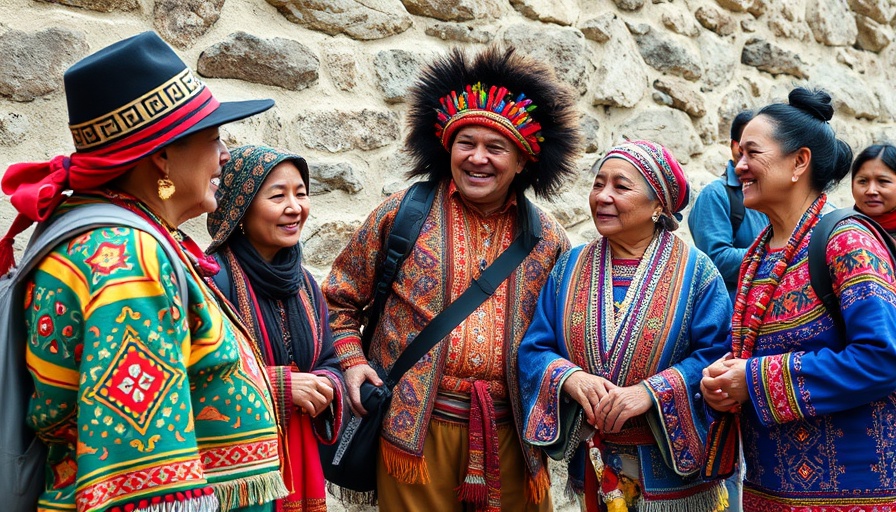
The Diversity of South America: More than Meets the Eye
When dreaming about travel destinations, many envision vast landscapes, exotic cultures, and culinary delights unique to each region. South America is no exception; however, it often falls victim to a perennial misunderstanding: the notion that it’s homogenous. Just as the continent is rich in biodiversity, each country possesses its own distinct culture, geography, and culinary traditions. If you're contemplating your next travel adventure, it's critical to embrace that diversity.
In 22 Mistakes Tourists Make in South America, the discussion dives into common travel pitfalls, exploring key insights that sparked deeper analysis on our end.
Safety and Comfort: Debunking Myths About Traveling
A common mistake among first-time travelers is surrendering to fear and believing exaggerated myths surrounding safety. Many associate South America with danger, but it's essential to remain grounded. Thousands of travelers venture through Colombia, Peru, and Brazil without incident every day. It’s more about remaining aware and prepared. For example, in cities like Rio de Janeiro or Medellin, common sense prevails—avoid displaying valuables and steer clear of isolated areas at night. Just as one would take precautions in any metropolitan area globally, remaining cautious in South America can lead to a worry-free experience.
Understanding Cultural Nuances: Embracing the Close Contact
Forget about personal space; South America thrives on a cozy, social dynamic. Public transportation often sees you squeezed into buses, cheek-to-cheek with strangers. Instead of shying away, embrace these interactions and connect with locals on a more personal level. Learning to greet with a kiss on the cheek isn’t just a friendly gesture—it’s an invitation to experience the warm-hearted nature of South American culture.
Essential Travel Tips: Don't Miss Out on the Local Markets
Markets across South America are teeming with life, colors, and flavors that you can't afford to miss. From the vibrant artisan stalls in Oruro, Bolivia, to the bustling food markets of Ecuador, these locales embody the essence of local cultures. Sample street food, engage with vendors, and experience the heart of the city—this interaction will sculpt your understanding of each destination far beyond what travel brochures can deliver.
Education is Key: The Importance of Research Before You Travel
Diving into South America requires more than just a plane ticket; it demands research to effectively enhance your trip. Understand when to visit which sites, the varying climatic conditions—because December in the Southern Hemisphere is summer—and the cultural calendar. Familiarize yourself with potential visa requirements that differ from country to country, and make sure to check your itinerary against local laws and customs.
The Art Scene: Capturing the Cultural Essence
Don’t confine your experiences to famous museums; South America boasts a thriving street art scene that speaks volumes about social issues, history, and local pride. In cities like Bogotá, Colombia, or Valparaiso, Chile, street murals tell stories that deserve to be explored. Participating in local culture is far richer than just observing—it provides context to your memories.
Family-Friendly Adventures: Thrills for Everyone
Traveling with kids? South America is laden with adventure. From the exhilarating sandboarding in the Atacama Desert to zip-lining in Costa Rica, there's no shortage of family-friendly activities that can keep younger travelers engaged. Many families find that their children embrace the spontaneity of outdoor adventures in South America far more than typical sightseeing tours elsewhere.
Smart Travel: Getting Around Efficiently
Don't overlook the extensive bus networks that stitch together towns and cities across the continent. Buses might be long, but they provide a budget-friendly alternative to flying and allow for glimpses of the picturesque landscapes that aircraft simply can’t offer. However, not all bus companies provide the same comfort, so opt for executive services for a better experience. Pack snacks and entertainment; those lengthy journeys can test the patience of even the most seasoned travelers.
Language Barrier: Connection Over Confusion
Despite the widespread assumption that English is the universal language, South America is not as accommodating. Not everyone speaks English, and understanding at least some Spanish or Portuguese can significantly enhance your experience. Consider learning basic phrases—it not only makes interactions smoother but can also open doors to genuine connections.
Preventing Mishaps: Safety Precautions to Consider
South American adventures should be exhilarating; however, travelers must remain vigilant. Keep emergency numbers on hand and download essential apps such as WhatsApp for communication. It’s also prudent to book taxis through trusted services instead of hailing random ones during nighttime outings. Planning your transportation can mitigate risks significantly.
Don't Rush Your Experience: Enjoy the Journey
Lastly, avoid the trap of rushing through your itinerary. Take time to appreciate your surroundings, whether it be in the bustling streets of Buenos Aires or the tranquil beaches of Brazil. Every moment of leisure fosters connections with locals and creates cherished memories. The essence of travel is not merely to see but to experience.
In conclusion, if you're planning to venture into South America, keep these insights in mind to ensure a remarkable journey. Each mistake prevented means more opportunities to enjoy the splendors of this magnificent continent. By staying informed and open to the unfamiliar, you’ll create memories that last a lifetime.
 Add Row
Add Row  Add
Add 




Write A Comment